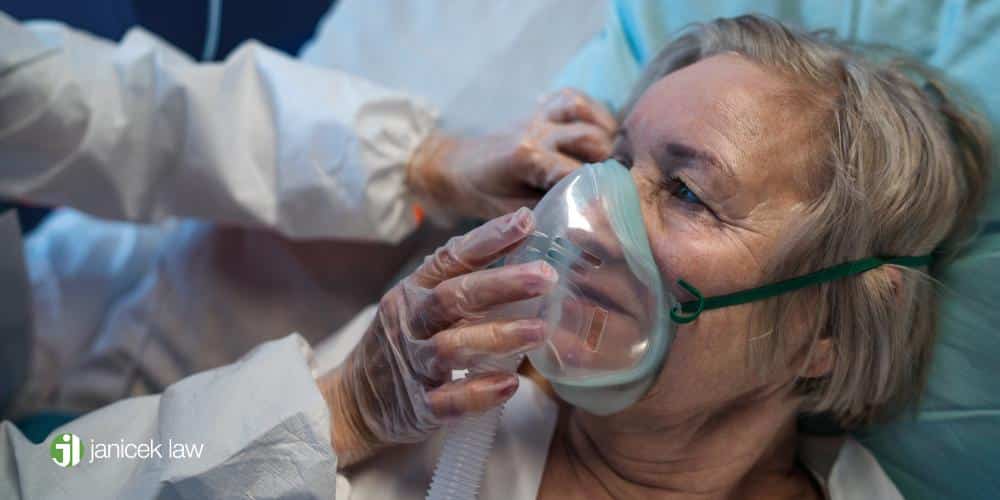San Antonio Nursing Home Sepsis Attorneys
Sepsis in San Antonio Nursing Homes
Sepsis is basically a severe complication from a pre-existing infection. A severe stage of sepsis can certainly be deadly, especially without quick medical treatment. Elderly people generally have a higher risk of developing sepsis than the rest of the young population. But this risk is even higher for nursing home residents who are actively suffering from nursing home neglect and abuse. At Janicek Law, our experienced team of elder abuse lawyers have what it takes to obtain justice for those who have suffered the physical, emotional, and financial consequences of sepsis in nursing homes. Call us today at 210-366-4949 to schedule a free legal consultation with an experienced San Antonio nursing home sepsis attorney.

What is Sepsis?
Sepsis is a life threatening condition that occurs in response to a bacterial, fungal, or viral infection. Pre-existing bacterial and viral infections can trigger major inflammation throughout the body while the immune system tries to fight it off. The body’s response to a severe infection can trigger sepsis and septic shock, especially in people who have a weakened immune system due to chronic illness.
A sepsis infection is a medical emergency that requires immediate treatment. Without early diagnosis and medical treatment, the sepsis sufferer can die.
There are three stages of sepsis – ranging from mild sepsis to septic shock. People who are exhibiting the early signs of sepsis have the best chance of survival, especially with immediate medical attention. Meanwhile, people whose sepsis worsens into septic shock have the lowest chance of survival.
Sepsis Symptoms
The severity of sepsis symptoms often depends on the stage of sepsis that the patient is currently enduring. For example, early symptoms of sepsis can be fairly mild, often resembling the symptoms of a regular infection. Meanwhile, symptoms of septic shock (AKA severe sepsis) are debilitating and deadly.
Listed below are the common symptoms of sepsis or septic shock.
- Fever or low body temperature
- Chills
- Rapid breathing (hyperventilation)
- Hypotension, which is low blood pressure (systolic blood pressure less than 100 mm Hg)
- Abnormal blood clotting and overall poor blood flow
- Excessive sweating
- Disorientation and confusion
- Shaking
- Chronic pain
- High lactic acid levels which indicates that the body isn’t using very much oxygen
- Extreme weakness
- Lips, fingers, and toes that have a bluish tint
What Are the Three Stages of Sepsis?
Once someone starts showing sepsis symptoms, doctors will run several tests which can help them determine what stage of sepsis that the patient is currently enduring. A doctor may order a blood test in order to determine vital organ function, oxygen levels, electrolyte imbalances, clotting problems, white blood cell count (which indicates infection), etc. Additionally, doctors may conduct a urine test and check the body for any open, infected wounds. The information from all of these tests can help doctors determine if the patient is enduring sepsis or septic shock.
The first stage of sepsis can be difficult to diagnose because many of the symptoms are similar to whatever type of viral, fungal, or bacterial infection triggered the sepsis. So a patient may experience fever, chills, racing heart, and breathing difficulties, which can be similar to symptoms of a respiratory infection, for example.
The first stage of sepsis is also known as Systemic Inflammatory Response Syndrome (SIRS), which is sort of a precursor to this condition. In other words, SIRS can turn into sepsis, but only if the body is already fighting off an infection. In order for a doctor to diagnose SIRS, at least 2 of the following symptoms must be present:
- A body temperature above 100.4°F or below 96.8°F
- A heart rate above 90 BPM
- Less than 32 mm Hg of arterial carbon dioxide tension
- High white blood cell count levels
- Rapid breathing – more than 20 breaths per minute
Most patients recover from SIRS and/or the first stage of sepsis. In fact, the mortality rate for this stage of sepsis is only about 7%.
Stage 2 is considered severe sepsis. This stage is marked by the beginning of organ failure and dysfunction. Signs that vital organs are starting to shut down include low urine output, decreased blood flow, dangerously low blood pressure, and mental confusion.
The most severe stage of sepsis is septic shock. Septic shock symptoms often represent complete organ failure. For example, the blood pressure drops even more, urine output continues to decrease (indicating kidney failure), lactate levels increase, and hypothermia continues.
More than 50% of septic shock sufferers die according to this study.
What Causes Sepsis in San Antonio Nursing Homes?
Sepsis occurs due to severe viral, bacterial, or fungal infections. Common infections and health conditions that can lead to sepsis include:
- UTI’s
- Kidney infections
- Abdominal infections
- Respiratory viruses and infections that lead to pneumonia
- Blood poisoning (bacteremia)
- Infected bedsores
- Methicillin-Resistant Staphylococcus Aureus (MRSA) infections in San Antonio nursing homes
- Severe burns
Risk Factors for Sepsis and Septic Shock in San Antonio
Certain types of people have a higher risk of developing severe sepsis and septic shock than others, including:
- People with a weakened immune system due to age or chronic illness
- People who have chronic medical conditions such as kidney disease, liver disease, diabetes, cancer, AIDS, etc.
- Intensive care unit patients
- Nursing home residents
- People who need invasive devices such as breathing tubes and catheters
- People who have had sepsis before
- Infants
- People who frequently take antibiotics and steroids for various infections
To learn more, contact a San Antonio sepsis lawyer for a free consultation.

How Many Americans Suffer From Sepsis Every Year?
The Centers for Disease Control (CDC) states that approximately 1.7 million Americans suffer from sepsis and septic shock on an annual basis. 350,000 people who develop sepsis do not survive.
People who are over the age of 65 have a much higher risk of developing severe sepsis and septic shock compared to the rest of the U.S. population. The risk is even higher for people older than 85. Additionally, Americans over the age of 85 are 5 times more likely to die from severe sepsis and septic shock compared to people between the ages of 65 and 74.
Sepsis Treatment
The main way to treat sepsis is to treat the underlying infection, manage sepsis symptoms, and prevent vital organs from shutting down. Common sepsis treatment options include:
- Intravenous Antibiotics to treat the underlying infection.
- Intravenous Fluids to prevent dehydration.
- Steroids to treat the body’s inflammatory response.
- IV Pain Medications to make the patient feel more comfortable.
- Vasopressors to increase blood pressure.
Severe sepsis and septic shock treatment may require further medical intervention in order to prevent complete organ failure. For example, if the kidneys are showing signs of failure, then a doctor will resort to kidney dialysis. This type of procedure performs the same functions that healthy kidneys do: it filters waste, water, and salt from the bloodstream. Also, if the patient is struggling to breathe – and is therefore suffering from low oxygen levels – then a doctor may resort to a breathing tube.
What is Post Sepsis Syndrome?
Post Sepsis Syndrome (PSS) is a condition that sepsis or septic shock survivors commonly suffer from. In fact, Sepsis Alliance claims that up to 50% of sepsis survivors suffer from this condition.
Common PSS symptoms include chronic fatigue, chronic musculoskeletal pain, poor organ function, lack of appetite, insomnia, limb swelling, mental health issues, recurrent sepsis cases, and so much more.
Why San Antonio Nursing Home Residents Have an Increased Risk of Developing Sepsis
The average elderly person suffers from a weakened immune system mostly due to age, but also due to various health issues. This means that a fairly minor viral infection can cause serious health complications.
Nursing home residents specifically have an increased risk of developing sepsis because of their weakened immune system but also because of nursing home neglect and abuse. It’s fairly easy for older people to contract a viral, fungal, or bacterial infection. So an entire building of sick, elderly people can be a recipe for disaster, especially if nursing home negligence is happening. Negligent acts that can lead to frequent sepsis cases include poor hygiene, bedsores, malnutrition, dehydration, failing to provide medical treatment during the early signs of sepsis, and more.

Is Sepsis in Nursing Homes a Sign of Abuse and Neglect?
Sepsis or septic shock can be a sign of nursing home abuse and neglect, but not always. It’s important to remember that all elderly people are at risk of sepsis, even if they’re not in a nursing home, just because of the natural decrease in immune system functions. It’s entirely possible for a nursing home resident to develop sepsis despite having excellent care in their facility.
But if your elderly loved one had a lengthy history of infections, malnutrition, dehydration, and poor hygiene that preceded their case of sepsis, elder abuse may have played a role. Additionally, nursing staff members who suspect sepsis in an elderly patient but fail to provide timely treatment can face an elder abuse lawsuit.
When sepsis occurs while an elderly person is living in a nursing home, it can be really difficult to determine whether negligence is to blame. That’s why it’s crucial to speak with a San Antonio nursing home abuse and neglect lawyer at Janicek Law before taking legal action. We will investigate your claim and determine if abuse and neglect directly caused the condition.
If My Elderly Loved One Died From Septic Shock in a San Antonio Nursing Home, Can I Sue?
The answer to this question depends on if nursing home abuse and neglect occurred AND if it directly caused the fatal septic shock. If our legal team can gather sufficient evidence to prove that negligence directly caused your elderly loved one to die from septic shock, then you can certainly file a wrongful death lawsuit against the facility.
Preventing Sepsis in Nursing Homes
Preventing severe sepsis and septic shock is crucial for the longevity of nursing home residents. If your elderly loved one’s nursing facility is failing to take the following precautions, you may have grounds to file an elder abuse lawsuit.
- Keeping the nursing facility clean.
- Providing clean bedsheets, towels, and clothing.
- Helping the elderly person bathe and stay clean every day.
- Helping the elderly person go to the bathroom OR changing diapers in a timely manner.
- Making sure elderly people stay well-nourished and hydrated.
- Treating all infections and health conditions immediately.
- Ensuring that sick staff members stay home.
- Ensuring that all visitors wear masks and take their temperatures before walking in the facility.
- Changing gloves and gowns in between patients.
- Washing or sanitizing hands in between patients.
- Helping bed bound or immobile patients change positions every few hours to prevent bedsores.
Damages for Nursing Home Abuse and Neglect
If your elderly loved one suffered from severe sepsis in their nursing home, you may have grounds to recover financial compensation for the following types of damages.
- Past and future medical bills
- Past and future physical therapy bills
- Lost wages
- Physical pain and suffering
- Emotional distress
- Funeral and burial expenses if septic shock resulted in wrongful death

San Antonio Nursing Home Sepsis Lawyer
In many cases, nursing home neglect and abuse can go hand in hand with severe sepsis, septic shock, and death. That’s why San Antonio elder abuse lawyers at Janicek Law stand by to help grieving families determine if they have grounds to sue their loved one’s nursing facility. Call us today at 210-366-4949 to schedule a free consultation.
